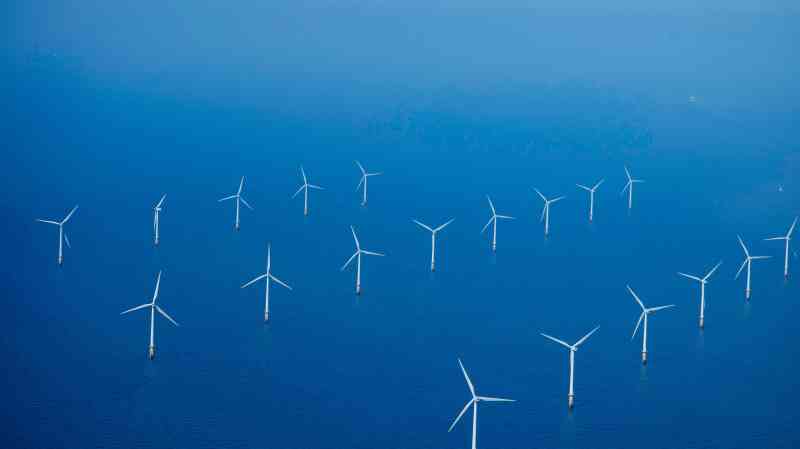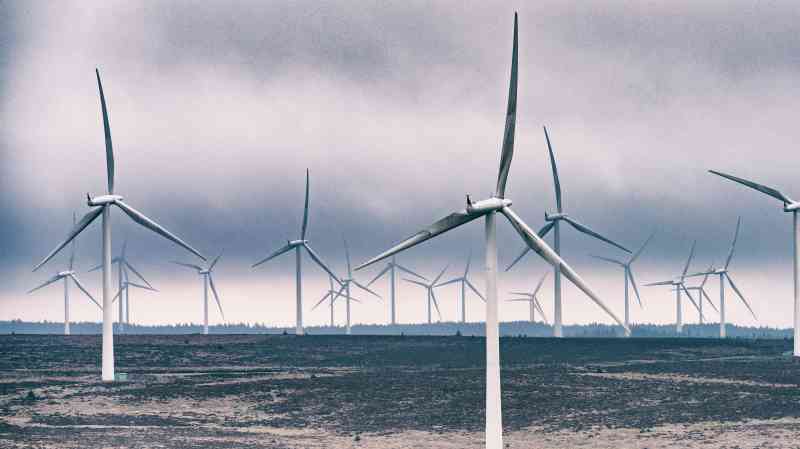Shell looks to inflate case for generating power offshore
Royal Dutch Shell hopes to boost the profits it makes from offshore wind farms by using surplus electricity to produce hydrogen and to charge batteries at sea.
The oil company claims that using such technologies to store energy, as well as installing floating solar panels next to the turbines, should enable it to offer “a continuous power supply”, even when the wind isn’t blowing.
Shell is preparing to put the technologies through trials at a new wind farm it is building off the coast of the Netherlands. If they are successful, they could be deployed more widely across the industry, according to the company.
This would better utilise the cables that link the wind farms to shore and would boost returns for developers by enabling them to store surplus power on windy days, when the market is swamped with electricity, and sell it for more money later.
The Anglo-Dutch business is one of the biggest oil groups in the world, worth approximately £90 billion. It explores for and produces oil and natural gas and sells a wide variety of fuels. It is expanding its offshore wind operations as part of its plans to build a significant low-carbon electricity business and to cut its emissions to “net zero” by 2050.
Shell and Eneco, its partner, won a tender late last month to build the Hollandse Kust project just over 11 miles off the Dutch coast.
The wind farm, which is not subsidised, will have 69 turbines and is expected to generate enough power over a year to meet the needs of a million homes. Its output will fluctuate from 759 megawatts when the turbines are spinning full-tilt to nil on a windless day.
Dorine Bosman, Shell’s vice-president for offshore wind, said that the technologies it would test at the site were intended to “stabilise the output and dampen the peaks and troughs that we might see in normal straight offshore wind operations”.
It was too early to say what level of power output could be maintained by using the technologies combined, but “that’s exactly why this is innovation. Let’s see what it all does, how it all links up together. . . . We just don’t do innovation for innovation’s sake.”
The hydrogen will be produced through electrolysis on very windy days, when the wind farm may be generating more power than is needed, and will be turned back into electricity using hydrogen fuel cells when it is calm. The battery will operate on the same principle. Ms Bosman, 57, said that she had not seen either storage technology used alongside turbines before. The floating solar panels will offer additional power when it is sunny.
She said that the proposal was more efficient than installing complementary generation and storage onshore because it would make better use of the power transmission cables.
For Shell, the technologies could enable higher returns, especially in subsidy-free systems, as in the Netherlands, where revenues depend on market prices. “When all the wind parks are on, the system gets flooded with offshore wind power,” Ms Bosman said. Excess power generated when prices are low or negative could be stored for sale when supplies are scarce and prices are higher.
London-listed shares in Shell fell by 29p, or 2.5 per cent, to £11.31½ yesterday.
Green lights flash over oil sectorOffshore wind is emerging as a key focus in the oil majors’ efforts to go green. Royal Dutch Shell co-owns one small wind farm off the Netherlands and is in a consortium building a second, much larger project that generated its first power last week. It has secured the rights to develop two leases off the United States and aims to enter the British market, the world’s biggest. It is expected to give more detail on its plans at an update in February.
Last week BP, its smaller rival, confirmed that it intended to enter the offshore wind sector, while Total, of France, and Equinor, of Norway, have interests in British offshore wind projects and ambitions to develop much more capacity.
Increased competition for offshore leases and for subsidy contracts in countries such as the UK is likely to place pressure on returns. However, oil companies believe that they can amplify returns with how they finance the projects and by using their trading divisions to optimise sales.
Dorine Bosman, of Shell, said that it was aiming for returns of 8 per cent to 12 per cent in renewables, including in offshore wind. Contracts such as those in the UK that offered fixed prices for the electricity helped, she said.
“Once a wind park is operational, most of the risk is out, particularly if you are on the back of secured revenues. That’s why you can get project financing from banks and low-risk equity investors that are interested in these assets. So there’s still a developer’s premium to be had.”






